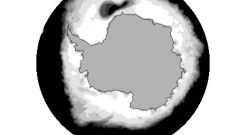A new study suggests that an enormous opening in the sea ice that surrounds Antarctica in winter was nature’s way of releasing heat from the deep southern ocean.
“Was”, because the opening or “polynya” seen in early satellite images of the Weddell Sea between 1974 and 1976, has not reappeared since. Scientists think the climate has changed along with surface water salinity and has blocked this important phenomenon, perhaps for centuries to come.
Eric Galbraith (PhD) is a co-author and co-superviser of the study. He is an assistant professor in the Department of Earth and Planetary Sciences at McGill University in Montreal
The mixing between the upper and lower ocean that took place inside the winter polynya was also a way of bringing oxygen kilometres down to the abyssal ocean.

The fact that it has not reappeared since the 1970’s originally led scientists to think it was a rare natural occurrence.
New evidence by the scientific team from McGill and the University of Pennsylvania suggest that the winter polynya is being suppressed due to climate change.
The research suggests that because of more rain and melting snow and ice, the upper surface has become much fresher (lowered salinity) and is acting like a lid keeping the denser deep ocean water trapped beneath. This has prevented the slightly warmer water current from reaching the surface, melting the ice and releasing its heat.

Sea ice (white) surrounds Antarctica in this image based on satellite data from 1974-1976. The dark area in the upper part of the image shows the extent of the Weddell Sea polynya (the size of New Zealand) during the polar winters of those years. Climate change appears to have cut off the flow of this enormous deep ocean current and mixing of upper and deep ocean layers (Casimir de Lavergne; NSIDC) *CLICK ON IMAGE FOR FULL VIEW*
“Deep ocean waters only mix directly to the surface in a few small regions of the global ocean, so this has effectively shut one of the main conduits for deep ocean heat to escape.” says Casimir de Lavergne, a recent graduate of McGill’s Master’s program in Atmospheric and Oceanic Sciences and lead author of the paper.
After performing a series of modelling experiments the team found that their simulated polynya also disappeared when the surface salinity was reduced.
The team analyzed tens of thousands of measurements made by ships and robotic floats in the ocean around Antarctica over a 60-year period and showed that the salinity of the upper ocean has been diminishing since 1950.
The scientists also surveyed the latest generation of climate models, which predict an increase of precipitation in the Southern Ocean as atmospheric carbon dioxide rises. “This agrees with the observations, and fits with a well-accepted principle that a warming planet will see dryer regions become dryer and wetter regions become wetter,” says Jaime Palter, a professor in McGill’s Department of Atmospheric and Oceanic Sciences and co-author of the study. Indeed the southern ocean has been receiving more precipitation in recent years, which has been further reducing the salinity of the surface.
During 1974 to 1976, it is estimated that the flow of oxygen-rich waters from the surface to the abyss was more than double the flow of all the world’s rivers combined.”
Eric Galbraith, who is also a fellow of the Canadian Institute for Advanced Research, says, “Although our analysis suggests it’s unlikely, it’s always possible that the giant polynya will manage to reappear in the next century,”
He adds, “If it does, it will release decades-worth of heat and carbon from the deep ocean to the atmosphere in a pulse of warming.”







For reasons beyond our control, and for an undetermined period of time, our comment section is now closed. However, our social networks remain open to your contributions.